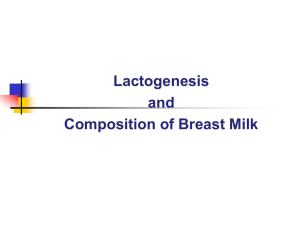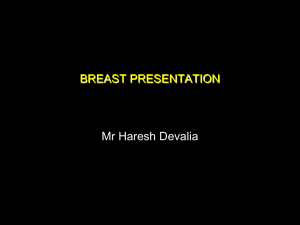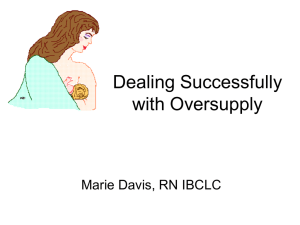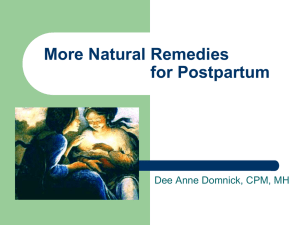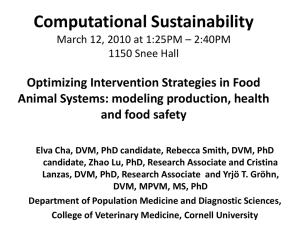Mastitis
advertisement
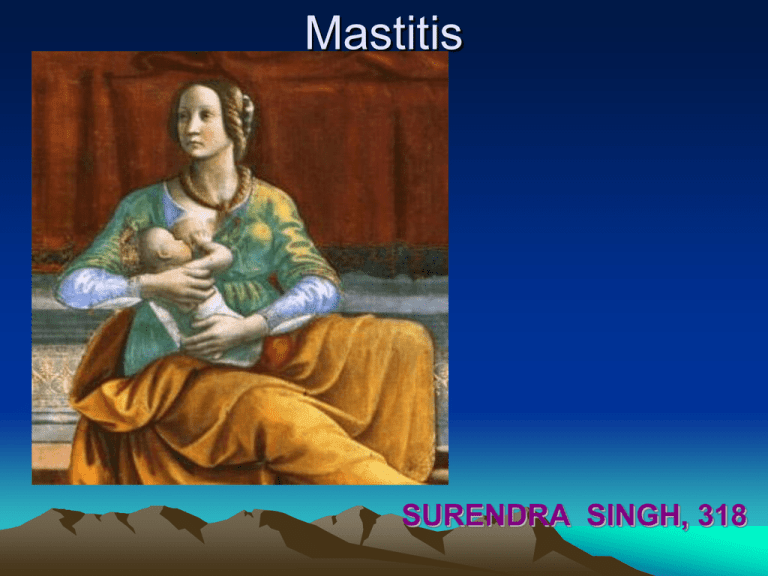
Mastitis SURENDRA SINGH, 318 Mastitis An acute inflammation of the interlobular connective tissue within the mammary gland Mastitis Normal breast architecture Outline • • • • • • • Epidemiology Presentation Predisposing factors Microbiology Treatment Complications Effect on breast milk Epidemiology • Incidence 2-33% – ACOG reports 1-2% in U.S. – Most common worldwide <10% • Most common 2nd-3rd week postpartum – 74-95% in first 12 weeks – Can occur anytime in lactation Presentation • Systemic illness: Chills, myalgias • Fever of ≥ 38.5 • Tender, hot, swollen wedge-shaped erythematous area of breast • Usually one breast Differential Diagnosis • Fullness: bilateral, hot, heavy, hard, no redness • Engorgement: bilateral, tender, +/- fever, minimal diffuse erythema • Blocked Duct: painful lump with overlying erythema, no fever, feel well, particulate matter in milk Differential Diagnosis • Galactocele: smooth rounded swelling (cyst) • Abscess: tender hard breast mass, +/fluctuance, skin erythema, induration, +/fever • Inflammatory Breast Carcinoma: unilateral, diffuse and recurrent, erythema, induration Causes • Milk Stasis – Stagnant milk increases pressure in breast leading to leakage in surrounding breast tissue – Milk, itself, causes an inflammatory response • +/- Infection – Milk provides medium for bacterial growth Causes • 3 groups – Milk stasis (bacteria<10^3, leuk<10^6) – Noninfectious inflammation (bacteria <10^3, leuk >10^6) – Infectious (bacteria >10^3, leuk>10^6) • Randomized treatment – No intervention – Systematic emptying of breast – Infectious group with 3rd intervention: antibiotics (PCN, Amp, Erythro) and systematic emptying Causes • “Poor results” – Milk stasis (10) – 3 recurrences, 7 impaired lactation – Noninfectious (20) – 13 recurrences – Infectious (76 – only 2 in Abx group) – 6 abscesses, 21 recurrences • Could not clinically tell difference between the groups without lab data. • Conclusion: Treat with antibiotics Predisposing factors • Improper nursing technique – Timing of feeds – Poor attachment • Oversupply of milk – – – – Overabundant milk supply Lactating for multiples Rapid weaning Blocked nipple pore or duct • Pressure on Breast – Tight Bra – Car seatbelt (yes, this is actually listed) – Prone sleeping position Predisposing factors • • • • • • • • Damaged nipple (nipple fissure) Primiparity Previous history of mastitis Maternal or neonatal illness Maternal stress Work outside the home Trauma Genetic Microbiology • Detection of pathogens difficult – Usually nasal/skin flora – Difficult to avoid contamination • Milk culture – Encouraged in hospital acquired, recurrent mastitis, or no response in 2 days Microbiology • Staph Aureus • Coag neg staph • Also, Group A and B βhemolytic Strep, E Coli, H. flu • MRSA • Fungal infections • TB where endemic – 1% of cases Fungal infections • Based on case reports that anti-fungal cream improves sx • Case reports of cyptococcal infection • Most common: Candida Albicans – Genital tract Newborn oral colonization • May lead to nipple fissure • Thought to be associated with deep, shooting pains and nipple discomfort • Most commonly treated with fluconozole to ♀, oral nystatin to infant Candida Infection Treatment • Supportive Therapy – Rest, fluids, pain medication, anti-inflammatory agents, encouragement • Continue breast feeding • Antibiotics that cover Staph and Strep – – – – Culture results Severe symptoms Nipple fissure No improved after 12-24 hours of milk removal Treatment (ACOG) • Dicloxicillin 500 mg qid • Erythromycin if PCN allergic • If resistant to treatment penicillinaseproducing staph, then vancomycin or cefotetan until 2 days after infection subsides • Minimum treatment 10-14 days Treatment (Alternative) • Therapeutic U/S • Accupunture • Bella donna, Phytolacca, Chamomilla, sulphur, Bellis perenis • Cabbage leaves • Avoid drinks like coffee with methylxanthines, decreasing fat intake Complications (Other bad things related to mastitis) Breast Abscess Breast Abscess Breast abscess with early skin necrosis Abscess • • • • Most common in first 6 weeks 5-11% of mastitis cases Affect future lactation in 10% of affected ♀ No differences b/t groups by age, parity, localization of infection, cracked nipples, + milk cultures, mean lactation time • Duration of symptoms: only independent variable favoring abscess development Breast Abscess Inflammatory breast cancer Other Complications • Distortion of breast • Chronic inflammatio Granulomatous Mastitis • Noncaseating granulomas in a lobular distribution • Differential Diagnosis – – – – TB mastitis Foreign body Fat necrosis Autoimmune: sarcoid, erythema nodusum, polyarthritis • Presentation – Unilateral Breast lump – No infection identified at presentation Granulomatous Mastitis • Can mimic Breast Ca on clinical, radiological, and cytological exams • Diagnosis: Histology • Treatment: – Antibiotics not helpful – Corticosteroids – Excision biopsy • Limited literature, but no clear association with breast feeding, OCPs Neonatal Mastitis Neonatal Mastitis • Occurs up to 5 weeks of age • Girls outnumber boys 2 : 1 • Etiology: 85% S. aureus, also E. coli, group D Streptococcus • Treatment: – Prompt antibiotics (IV?) – Careful needle aspiration if abscess Effect on Milk Immune Factors • IgA is predominant in milk • Increased immune factors from both plasma and local epithelial cells • No adverse events documented in peds – Poor growth documented likely related to poor milk production – Contradictory studies showing benefit or harm • Interest in pediatric vaccine development Michie 2003, Filteau 2003 Increased HIV transmission risk • Alternating breast/bottle increased risk • Role of free virus vs cell bound virus unclear • If ♀ must breast feed, then pump on affected breast (pasteurize) and feed on unaffected Michie 2003, Filteau 2003 Mastitis

